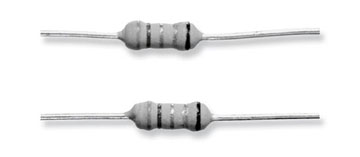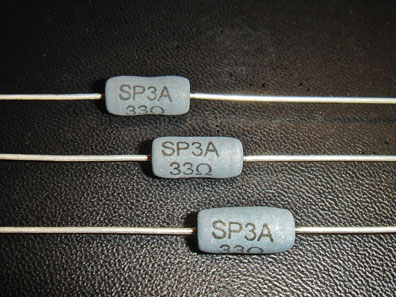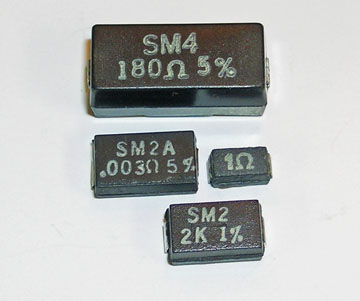BY KORY SCHROEDER, Director of Marketing & Product Engineering,
Stackpole Electronics
www.seielect.com
Fusible resistors are a preferred passive component for many design engineers because they combine two roles: a fuse and a resistor. Using one component versus two saves costs and PCB space. Fusible film resistors are ideal for applications with a lower power level and in which the overload- and surge-handling requirements are not too severe. Power supplies and control circuits commonly used in electric power tools, utility meters, communications equipment, kitchen appliances, and smoke detectors often need a more robust resistor that can withstand higher power, higher short-term pulses, and higher temperatures. These applications require resistors with various levels of surge handling and the conflicting requirement of fusing or failing without collateral damage, and this is where the wirewound type fits the bill.
Fusible film resistors
Fusible film resistor technology typically uses the standard resistor film alloy and materials as a basis for a fusible part. To ensure a reliable and repeatable fusing characteristic, the sputtered film thickness and composition must be more carefully monitored to ensure uniformity across the manufacturing lot. After the filming process, the calibration step is the most critical. It is this process that controls the fusing action of the part, along with dictating the exact resistance value. The more calibration trimming, the shorter the fusing time or the lower the power needed to fuse a given size and resistance value.

Fig. 1: A typical fusible film resistor.
However, the resistance value of a given manufacturing lot will vary widely when the calibration trim is used to control fusing time. This variation in resistance value can also cause variation in fusing performance because higher resistance values will fuse quicker. Many fusible resistors, therefore, are only offered in 5% or higher absolute resistance tolerances. Typical fusing characteristics are stated as fusing time (typically less than 30 seconds, 15 seconds, 5 seconds, etc.) at a specified magnification of power such as 10X, 15X, or 25X. Fusible film resistors are used in a variety of low-power and low-surge applications. These include low-level fire-safety monitoring and management, high-end audio/video systems, environmental management controls and systems, and laser printers.
Fusible wirewound resistors
A typical fusible wirewound application will require the fusing resistor to pass some type of short transient event without failing. The appliance and white goods industry, electric power tools, utility meters, communications equipment, fire safety equipment, and HVAC systems all have requirements of this type. An example is a fusible wirewound that must pass hundreds of 20-µs pulses of 6,000 V without failure, but must fuse quickly and without flames when subjected to 120-V short-circuit overloads. While it is relatively easy to build a wirewound resistor that can withstand the 6-kV surges, it is much more difficult to maintain that while also having a fusing characteristic that opens without flame or excess heat generation.

Fig. 2: The SP3A series pulse-withstanding fusible wirewound.
Some manufacturers create the fusing action of the wirewound by simply making one of the two welds of the element to the end-cap weaker. While this does create a failsafe characteristic, the repeatability for this fuse design is much less than one would desire. In some cases, the part will fuse under normal circuit conditions, and in others, the part will not fuse until the PCB is charred or even caught on fire. The more advanced fusible wirewound technology uses material properties of the resistance wire alloy, core size and shape, lead wire, and thermal management.
Another factor that can affect the performance of a fusible wirewound resistor is the trimming process. Any trimming will reduce the effective current-carrying capacity of the wire element. In some cases, the wire cross-section can be reduced by as much as 40%. The trim process generally doesn’t dramatically decrease the steady-state power handling of the wirewound resistor, but it will have a dramatic effect on the surge handling of the device. For example, a 5-W low-resistance value wirewound designed for pulse withstanding with minimal or no calibration trim may be able to handle around 70 joules of energy, while a standard commercial wirewound would only be guaranteed to handle 0.4 joules.

Fig. 3: The SM4 surface-mount wirewound resistor.
Fusible wirewound resistors, depending on the individual customer requirements, have only a small price premium over a standard unit. While the limits and restrictions on materials and trimming do increase manufacturing costs, the overall benefit of the failsafe performance usually outweighs any nominal price increase.
Increased interest in fusible and failsafe wirewounds
Many power supply design engineers can replace a wirewound resistor and separate fuse with a single failsafe wirewound. UL has recently put a new focus on the resistor and fuse used in motor controls and protection applications, with the objective to only use a single device. A single part will be more reliable and repeatable than two separate and independent components and will typically be less expensive. While the use of the thermal fuse lowers the effective power handling of the resistor, it does provide a very distinct fusing action that is guaranteed to protect the circuit if a certain temperature level is exceeded.
One big advantage
One of the biggest advantages to wirewound resistors is also one of its larger drawbacks for some applications: it is a very robust resistor technology. While this is very good for applications in which no significant overload is possible on a continuous basis, it presents a problem for applications that do have the potential for overpower conditions. The wirewound resistor will continue to heat up until it has destroyed itself and anything unlucky enough to be near it. Creating a reliable and repeatable fusing characteristic without dramatically reducing the steady-state power handling has allowed these wirewounds to be used in many applications in which a standard wirewound resistor simply cannot be trusted. With careful consideration of materials along with tightly controlled manufacturing processes, a device that fails safely yet withstands short surges of 6 kV or more can be produced without dramatically increasing the cost of the device.
Advertisement
Learn more about Stackpole Electronics





